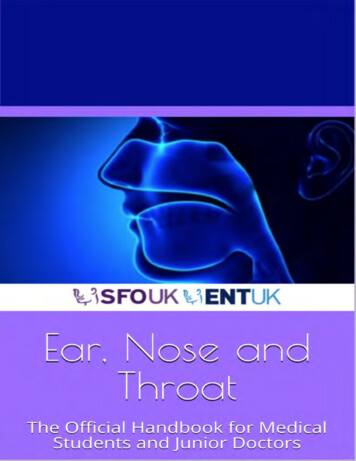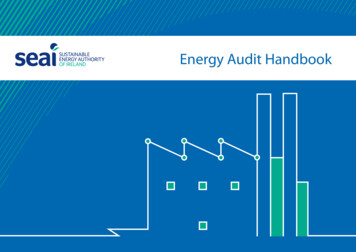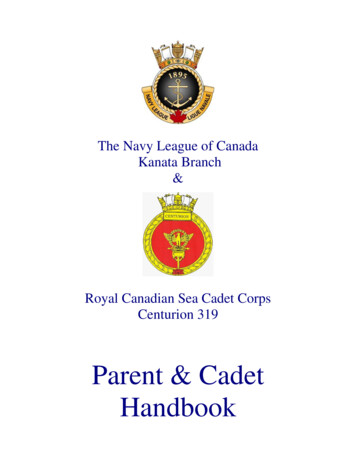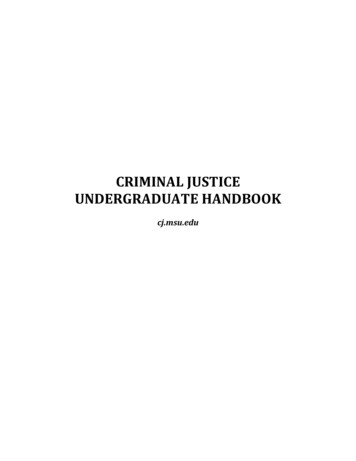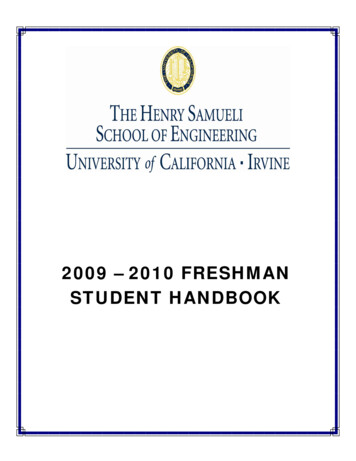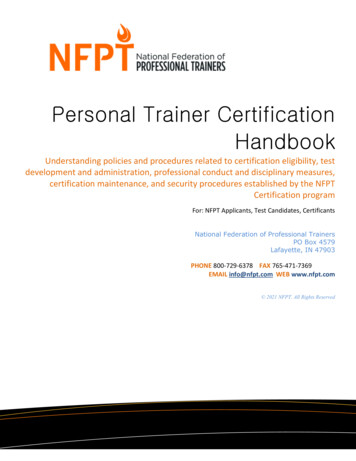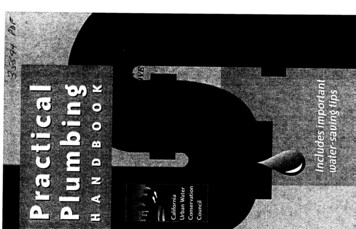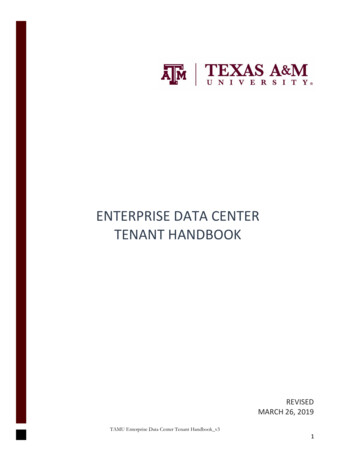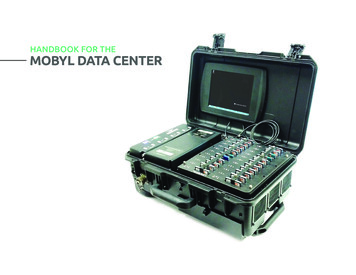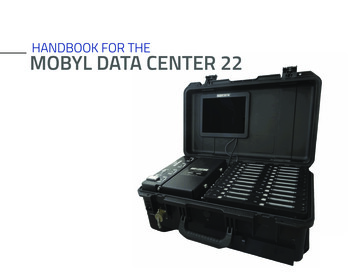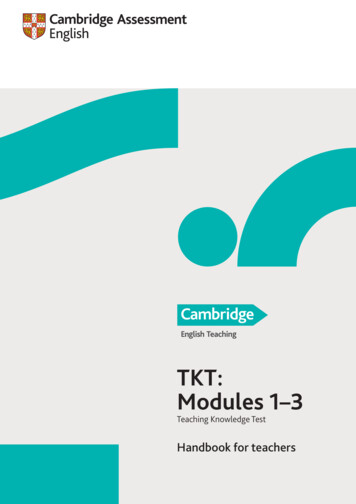
Transcription
TKT:Modules 1–3Teaching Knowledge TestHandbook for teachers
Make the most of your handbookThis handbook is intended for tutors and candidates and provides information to help prepare forTKT: (Teaching Knowledge Test) Modules 1, 2 and 3.For further information on any of our teaching qualifications and courses, please go tocambridgeenglish.org/teaching-qualificationsFor further copies of this handbook, please email marketingsupport@cambridgeenglish.orgAbout Cambridge Assessment English2Cambridge English teaching qualifications –an overview3Cambridge English Teaching Framework4Introduction to TKT6TKT: Modules 1–3: an overview6Support for candidates and course providers7TKT: Modules 1–3 administration7Special Circumstances8Module 19Syllabus10Describing language and language skills10Background to language learning11Background to language teachingSample paperModule 219Syllabus20Planning and preparing a lessonor sequence of lessons20Selection and use of resources20Sample paper21Module 329Syllabus30Teachers’ and learners’ language in the classroom30Classroom management30Sample paper3111Answer keys3812Sample answer sheet39TKT band descriptors41More Cambridge English teachingqualifications and courses42
About Cambridge Assessment EnglishWe are Cambridge Assessment English. Part of the University ofCambridge, we help millions of people learn English and prove theirskills to the world.For us, learning English is more than just exams and grades. It’sabout having the confidence to communicate and access a lifetimeof enriching experiences and opportunities.We deliver qualifications and tests in over 130 countries to over5.5 million people every year.The world’s most valuable range ofEnglish qualificationsCambridge English Qualifications are in-depth exams that makelearning English enjoyable, effective and rewarding.Our unique approach encourages continuous progression with aclear path to improving language skills. Each of our qualificationsfocuses on a level of the Common European Framework ofReference (CEFR), enabling learners to develop and build speaking,writing, reading and listening skills.To find out more about Cambridge English Qualifications and theCEFR, go to cambridgeenglish.org/cefrOne of the top universities in the worldCambridge English teaching qualificationsWe provide a comprehensive range of industry-leadingqualifications, professional development and resources forteachers, wherever they are in their professional journey.Departments of the UniversitySupporting teachersAll our teaching qualifications are mapped to the CambridgeEnglish Teaching Framework, which helps teachers identify wherethey are in their career development, where they want to be, andhow to get there.The largest assessment research capability of its kind in EuropeProven qualityDepartments (exam boards)Cambridge Assessment EnglishWe help millions of people learnEnglish and prove their skills to theworld.Cambridge AssessmentInternational EducationPrepares school students for life, helpingthem develop an informed curiosity anda lasting passion for learning.OCR: Oxford Cambridge and RSAExaminationsOxford Cambridge and RSAA leading UK awarding body.Our commitment to providing assessment of the highest possiblequality is underpinned by an extensive programme of researchand evaluation, and by continuous monitoring of the markingand grading of all Cambridge English Qualifications. Of particularimportance are the rigorous procedures which are used in theproduction and pretesting of question papers.All systems and processes for designing, developing and deliveringexams and assessment services are certified as meeting theinternationally recognised ISO 9001:2008 standard for qualitymanagement and are designed around five essential principles: Validity – are our exams an authentic test of real-life English orteaching knowledge? Reliability – do our exams behave consistently and fairly? Impact – does our assessment have a positive effect onteaching and learning? Practicality – does our assessment meet candidates’ needswithin available resources? Quality – how we plan, deliver and check that we provideexcellence in all of these fields.How these qualities are brought together is outlined in ourpublication Principles of Good Practice, which can be downloadedfree from cambridgeenglish.org/principles2
Cambridge English teaching qualifications –an overviewThe following qualifications are available to teachers through Cambridge English teaching qualification centres:TKT: Modules 1, 2 and 3Not requiredPrimary, secondaryor adults(Content and LanguageIntegrated Learning)Not essentialNot requiredPrimary, secondaryor adultsTKT: Young LearnersNot essentialNot requiredPrimaryNot requiredQualifcationsallowing accessto higher educationAdultsDiploma in Teaching English toSpeakers of Other LanguagesRecommendedInitial teachingqualifcationPrimary, secondaryor adultsDELTA Module TwoRequiredInitial teachingqualifcationPrimary, secondaryor adultsDELTA Module ThreeRecommendedInitial teachingqualifcationPrimary, secondaryor adultsTKT: CLILCELTACertifcate in Teaching English toSpeakers of Other LanguagesDELTA Module Teaching agegroupNot essentialTeaching Knowledge TestCan be takenpre-serviceQualifcation ate requirementsFace-to-face oronline/blendedoptionsExtendedassignmentThe following courses and qualifications are available to teachers through institutions and educational authorities:CELT-PLocal requirementsfor teachers applyPrimaryCertifcate in English LanguageTeaching – SecondaryRequiredLocal requirementsfor teachers applySecondaryTrain the l requirementsapplyStudents in highereducation contextsLanguage for Teaching – A2N/AA1 level EnglishPrimary, secondaryLanguage for Teaching – B1N/AA2 level EnglishPrimary, secondaryLanguage for Teaching – B2N/AB1 level EnglishPrimary, secondaryCELT-SCertifcate in EMI SkillsEnglish as a Medium of InstructionCambridge English teaching qualifcationsOnline/blendedlearningcourse ingpracticeCourseparticipationrequiredTeaching agegroupRequiredCertifcate in English LanguageTeaching – PrimaryCan be takenpre-serviceCourse/qualifcation ate requirements3
Cambridge English Teaching FrameworkWe developed the Cambridge English Teaching Framework: to help teachers identify where they are in their professional career to help teachers and their employers think about where they want to go next and identify development activities to get there.See the full version of the framework for detailed competency statements: oping Has a basic understanding of somelanguage-learning concepts. Has a reasonable understanding of manylanguage-learning concepts. Demonstrates a little of this understanding whenplanning and teaching. Demonstrates some of this understanding whenplanning and teaching. Has a basic understanding of some key principles ofteaching, learning and assessment. Has a reasonable understanding of many key principlesof teaching, learning and assessment. Can plan and deliver simple lessons with a basicawareness of learners’ needs, using coreteaching techniques. Can plan and deliver lessons with some awarenessof learners’ needs, using a number of differentteaching techniques. Can use available tests and basic assessmentprocedures to support and promote learning. Can design simple tests and use some assessmentprocedures to support and promote learning. Provides accurate examples of language pointstaught at A1 and A2 levels. Provides accurate examples of language points taught atA1, A2 and B1 levels. Uses basic classroom language which is mostly accurate. Uses classroom language which is mostly accurate.Languageknowledgeandawareness Is aware of some key terms for describing language. Has reasonable knowledge of many key terms fordescribing language.Professionaldevelopmentand values Can refect on a lesson with guidance and learnfrom feedback.Learning andthe learnerTeaching,learning andassessmentLanguageability4Foundation Can answer simple learner questions with the help ofreference materials. Requires guidance in self-assessing own needs. Can answer most learner questions with the help ofreference materials. Can refect on a lesson without guidance and respondpositively to feedback. Can self-assess own needs and identify some areasfor improvement.
ProfcientExpert Has a good understanding of manylanguage-learning concepts. Has a sophisticated understanding oflanguage-learning concepts. Frequently demonstrates this understanding whenplanning and teaching. Consistently demonstrates this understanding whenplanning and teaching. Has a good understanding of key principles of teaching,learning and assessment. Can plan and deliver detailed lessons with goodawareness of learners’ needs, using a wide range ofteaching techniques. Has a sophisticated understanding of key principles ofteaching, learning and assessment. Can plan and deliver detailed and sophisticated lessonswith a thorough understanding of learners’ needs, using acomprehensive range of teaching techniques. Can design effective tests and use a range of assessmentprocedures to support and promote learning. Can design a range of effective tests and use individualisedassessment procedures consistently to support andpromote learning. Provides accurate examples of language points taught atA1, A2, B1 and B2 levels. Provides accurate examples of language points taught atA1–C2 levels. Uses classroom language which is consistently accuratethroughout the lesson. Uses a wide range of classroom language which isconsistently accurate throughout the lesson. Has good knowledge of key terms for describing language. Has sophisticated knowledge of key terms fordescribing language. Can answer most learner questions with minimal use ofreference materials. Can refect critically and actively seeks feedback. Can identify own strengths and weaknesses as a teacher,and can support other teachers.Cambridge English Teaching Framework Can answer most learner questions in detail with minimaluse of reference materials. Consistently refects critically, observes other colleaguesand is highly committed to professional development. Is highly aware of own strengths and weaknesses, andactively supports the development of other teachers.5
Introduction to TKTTKT tests knowledge about English language teaching. Thetests are designed to encourage teachers in their professionaldevelopment and provide a step in their progression on theCambridge English Teaching Framework. Candidates can also useTKT to access further training and enhance career opportunities.TKT – an overviewTKT is divided into separate modules. Candidates can take themall, or choose the modules that meet their needs. A certificate isreceived for each module completed.The core modules are designed to provide a foundation in theprinciples and practice of English language teaching:Entry criteria and language requirementsCandidates are not required to fulfil any specific entry criteriafor TKT: Modules 1, 2 and 3 and there are no formal Englishlanguage requirements; however, candidates are expected tobe familiar with language relating to the practice of Englishlanguage teaching. A non-exhaustive list of teaching terminologyand definitions is provided in the TKT Glossary, which can bedownloaded from cambridgeenglish.org/tktWhat can successful candidates do with TKT?TKT increases teachers’ confidence and enables them to progressto other Cambridge English teaching qualifications. TKT: Module 1 – Language and background to languagelearning and teachingTKT is recognised as an English language teaching qualification bymany organisations and institutions around the world. TKT: Module 2 – Lesson planning and use of resources forlanguage teachingTest structure TKT: Module 3 – Managing the teaching and learning process.Teaching knowledge is assessed by means of objective-formattests, which are simple to administer and to take.There are further specialist modules, which can be takenseparately or added to the core modules: TKT: CLIL (Content and Language Integrated Learning)All three modules include a focus on theory and practice. Eachmodule consists of a timed pencil-and-paper test featuring 80multiple-choice questions.TKT: Modules 1, 2 and 3 test candidates’ knowledge of conceptsrelated to language teaching and learning, rather than theirproficiency in the English language, or their performance inclassroom situations. TKT: Young Learners.The aims of the modular formatThe format is designed to be accessible and offer candidatesmaximum flexibility, and therefore does not include a compulsorycourse component. However, it is likely that centres and otherinstitutions will wish to offer courses for TKT preparation.TKT: Modules 1–3: an overviewWho are TKT: Modules 1–3 suitable for?TKT: Modules 1, 2 and 3 test knowledge of concepts related tolanguage, language use and the background to and practice oflanguage teaching and learning.TKT is suitable for teachers of English in primary, secondary oradult teaching contexts.TKT: Modules 1, 2 and 3 may be taken by:6Approaches to teaching and learningA range of approaches to teaching and learning may be coveredin the test material. Materials are carefully selected so that theyare fair to candidates from all backgrounds and teaching contexts.Knowledge of communicative and other approaches to teachingis expected, as is familiarity with the common terminology ofEnglish language teaching (a non-exhaustive list of teachingterminology and definitions is provided in the TKT Glossary).Sources and text types used in TKT: Modules 1–3Extracts, original or adapted, from the following sources mayfeature in TKT: Modules 1, 2 and 3: English language teaching coursebooks or supplementarymaterials handbooks on English language teaching and learning English language teaching journals and magazines testing materials pre-service teachers grammar books and dictionaries, including phonemictranscription (IPA – International Phonetic Alphabet) teachers who wish to refresh and extend theirteaching knowledge diagrams or other visuals teachers who are moving to teaching English after teachinganother subject. descriptions of classroom situations transcriptions of classroom talk examples of learners’ writing.
Support for candidates andcourse providersSupport and general information for TKT, including adownloadable version of this handbook, can be found atcambridgeenglish.org/tktPreparing to take TKT: Modules 1–3It is not necessary to complete a course to enter for TKT: Modules1, 2 and 3. Candidates can prepare for their exam independently,or can if they prefer, follow a course provided by an exam orteaching qualification centre.Official Cambridge English preparation materials for TKT: Modules1, 2 and 3, including books and an online course, have been jointlydeveloped by Cambridge English and Cambridge University Pressand can be found at cambridge.org/cambridgeenglishMaterials for course providersFor course providers, teacher training session plans andother trainer resources can be found atcambridgeenglish.org/resources-for-teachersTKT: Modules 1–3 administrationEntry procedureCandidates must enter through an authorised Cambridge Englishexamination or teaching qualification centre. For a list of centres,go to cambridgeenglish.org/teachingcentresearchTKT tests are available throughout the year and examinationcentres select their own test dates. Entries must be made at leastsix weeks in advance of a test date.Please note that more notice may be necessary if candidates havespecial requirements and therefore need special arrangements(see section on Special Circumstances).For copies of the Regulations and more details on entryprocedure, current fees and further information about this andour other examinations, contact your local examination centre.ResultsCandidates receive a certificate for each module taken. Candidateperformance is reported using four bands.We also run free seminars and webinars for teachers, with replaysavailable on Cambridge English TV:A full set of band descriptors for each module can be found onpage 40.Webinars for teachers:cambridgeenglish.org/webinarsNotification of resultsSeminars and events:cambridgeenglish.org/eventsCambridge English TV:youtube.com/cambridgeenglishtvPretestingTKT results are issued to centres approximately two weeks afterwe receive the answer sheets in Cambridge.Please note that despatch of candidates’ results will be delayed ifthey need special consideration or if malpractice is suspected (seesection on Special Circumstances).Enquiries on results must be made through the candidate’s centre.Pretesting of TKT test material provides us with valuableinformation about candidates’ performance on particular tasks.Pretesting is also useful for centres or institutions, as it givescandidates the opportunity to familiarise themselves with TKTtask types under test conditions and to receive feedback on areasof strength and weakness.Appeals procedureIf your centre or institution would like to be involved in TKTpretesting, find out more atcambridgeenglish.org/about-pretestingCandidates should first contact their centre for advice.We provide a service to enable centres to appeal, on behalf ofcandidates, against assessment decisions that affect gradesawarded to candidates, e.g. decisions relating to results anddecisions relating to irregular conduct.For more information about the appeals procedure, go urther informationContact your local authorised exam centre or teachingqualification centre, or our helpdesk atcambridgeenglish.org/helpdesk for: current fees details of exam sessions more information about TKT and other Cambridge Englishteaching qualifications and exams.Introduction to TKT7
Special CircumstancesCambridge English exams are designed to be fair to all test takers.This commitment to fairness covers: Special arrangementsThese are available for candidates with a permanent orlong-term disability. Consult your Centre Exams Manager(CEM) for more details. Special considerationWe will give special consideration to candidates affectedby adverse circumstances such as illness or bereavementimmediately before or during an exam. Applications for specialconsideration must be made through the centre no later than10 working days after the exam date. MalpracticeWe will investigate all cases where candidates are suspectedof copying, collusion or breaking the exam regulations insome other way. Results may be withheld while they are beinginvestigated, or because we have found an infringement ofregulations. Centres are notified if a candidate’s results havebeen investigated.For more information about special circumstances go tocambridgeenglish.org/help8
1 hour 20 minsModule 1Language and background tolanguage learning and teachingPaper1Numberof tasks80Numberof marks80Task typesAnswer formatObjective tasks, such as matchingand multiple choice.Candidates indicate their answers byshading the correct boxes on theiranswer sheets.Candidates should use a pencil.Module 19
SyllabusDescribing language and language skillsThis module tests candidates’ knowledge of terms and conceptscommon in English language teaching. It also focuses on thefactors underpinning the learning of English and knowledge of therange and functions of the pedagogic choices the teacher has attheir disposal to cater for these learning factors.This part of Module 1 tests candidates’ knowledge of the termsand concepts common in English language teaching that are usedto describe language and its use, and language skills.TitleDescribinglanguage andlanguage skillsAreas of teachingknowledgeConcepts and terminology fordescribing language: grammar,lexis, phonology and functionsConcepts and terminology fordescribing language skills andsubskills, e.g. reading for gist,scanningTask typesand format6 tasksconsisting of40 questionsTasks includematching andmultiple choice.Candidates need to demonstrate an understanding of conceptsand terminology related to:Syllabus areaExample testing focusGrammar parts of speech the forms and use of grammatical structuresLexis types of meaning word formation, e.g. prefxes, suffxes,compounds word groupings, e.g. synonyms, antonyms,lexical sets, homophones, collocation registerFactors in the languagelearning process, e.g.Backgroundto languagelearning motivation exposure to language andfocus on form the role of error differencesbetween L1 and L2 learning learner characteristics, e.g. learning strategies learning preferences maturity past language-learningexperience learner needsThe range of methods, tasksand activities available to thelanguage teacher, e.g.Backgroundto languageteaching10 presentation techniques andintroductory activities practice activities and tasksfor language and skillsdevelopment assessment types and tasks appropriate terminology todescribe the above3 tasksconsisting of15 questionsPhonologyTasks includematching andmultiple choice.4 tasksconsisting of25 questionsTasks includematching andmultiple choice. symbols from the International PhoneticAlphabet (IPA) phonemes word stress, sentence stress intonation connected speechFunctions contextlevels of formalityappropriacya range of functions and their typical exponentsLanguageskills reading, listening, speaking, writing andtheir subskills features of spoken and written texts,e.g. layout, organisation, accuracy,fuency, authenticity
Module 1Background to language learningBackground to language teachingThis part of Module 1 tests candidates’ knowledge of factorsunderpinning the learning of English by speakers of otherlanguages. It focuses on those learner characteristics whichdistinguish one learner or group of learners from another in termsof their learning and those which affect both what and how ateacher chooses to teach a class or an individual learner. It alsotests candidates’ knowledge of aspects of the language-learningprocess and their impact on teaching.This part of Module 1 tests candidates’ knowledge of thepedagogic choices the teacher has at their disposal to cater forlearner characteristics, learning processes and the differencesbetween L1 and L2 learning. This part also tests knowledge ofconcepts and terms related to teaching and learning proceduresand activities, including assessment.Candidates need to demonstrate an understanding of conceptsand terminology related to the following and their implicationsfor the L2 classroom:Syllabus areaExample testing focusMotivation infuences on motivation the importance of motivation measures that can increase motivationExposure tolanguage andfocus on form acquisition silent period L2 learners’ need for interaction and focus onform as complements of exposureThe role of error errors and slips interference and developmental errors interlanguageThe differencesbetween L1and L2 learning differences in age differences in the context of learning differences in ways of learningLearnercharacteristics Learner needs the personal, learning and (future)professional needs of learnersModule 1 Syllabuscommon learning preferencescommon learning strategiesmaturitypast language-learning experienceshow learner characteristics affect learningCandidates need to demonstrate an understanding of methods,tasks, activities and terminology related to:Syllabus areaExample testing focusPresentationtechniques andintroductoryactivities introductory activities such as warmers andlead-ins common ways of presenting language the design and purpose of a rangeof common comprehension and productiontasks and activities teaching terms, e.g. prompting, eliciting,drillingTypes of activities frameworks for activities and tasksand tasks Presentation, Practice and Production (PPP)for language Task-based Learning (TBL)and skills Total Physical Response (TPR)development the Lexical Approach Grammar-Translation test–teach–test guided discoveryAssessmenttypesand tasks purposes for assessment, e.g. diagnostic,placement, achievement, formative,progress, profciency methods of assessment, e.g. self, peer,portfolio, informal and formal the design and purpose of a range ofassessment tasks and activities11
1254321Which of the three nouns is NOT an abstract noun?A ideaB emailC adviceI told Mark that it would be a bad idea to send the email, but he decided to ignore myadvice.Which of the three words is NOT a past participle form?A visitedB ruinedC builtWe visited a ruined castle which had been built in the eighth century.Which of the three words is NOT an adjective?A difficultB sureC rightIt’s a very difficult question. I’m not sure if I’ve done it right.Which of the three pronouns is NOT an object pronoun?A IB youC himI told you that I’d never seen him before.Which of the three verbs is NOT a main verb?A seemB haveC knowThe two artists seem to understand what you have painted, but I’m not sure I know.Mark the correct letter (A, B or C) on your answer sheet.Choose the correct answer.For questions 1 – 7, look at the sentences. Read the questions about the grammar in the sentencesand the three possible answers listed A, B and C.276Which of the three verbs is NOT an auxiliary?A hadB didC wasn’tTurn over Kip had always wanted to become a nurse. However, when he did a training course,he realised that he wasn’t enjoying it enough.Which of the three words is NOT an adverb?A QuiteB fewC neverQuite a few people in the class said they never brush their teeth in the evening.3
Module 1 Sample paperThanks a lot. You could leave now, if you’re in a hurry.You could try asking me before you use my comb, you know.The doctor is free. He could see you now if you like.111213to express future abilityGIt could snow! Look at the sky!to express present possibilityF10to express past abilityEI could hear a funny noise coming from somewhere in the engine.to express present abilityD9to give permissionCThat could be Judith on the phone.to complainB8Examplesto express future possibilityAUses of ‘could’There is one extra option which you do not need to use.Mark the correct letter (A – G) on your answer sheet.For questions 8 – 13, match the underlined examples of ‘could’ with their uses listed A – G.4191817161514false friends.connected g.collocations.lexical sets.word boundaries.phrasal verbs.verb patterns.homonyms.affixation.connected speech.ABCrhymes.key words.contrastive stress.Rare and hair; meat and street; money and sunny are examples of ABCThe different meanings of the noun bank are examples of ABCLook up; look out; look over are examples of ABCJeans, T-shirt, coat; and athlete, jog, long jump are examples of ABCRock hard; soft boiled; melting point are examples of ABCSee and sea; tale and tail; where and wear are examples of Mark the correct letter (A, B or C) on your answer sheet.Turn over For questions 14 – 19, look at the statements about lexis and choose the option (A, B or C) whichcompletes each statement.5Module 113
1426252423222120USAcan’tbyetwothreefour The first syllable of each word is always stressed.Structural words are never stressed.Content words are usually stressed. onetwothreeABCthink/thinkingshe/shipcut/catWhich of these words is a minimal pair?ABCHow many weak vowel sounds does banana have?ABCWhich of the following contains a diphthong?ABCWhich of the following is true of connected speech in English?ABCHow is butcher written in phonemic script? ABCHow many phonemes does place have?ABCWhich of the following contains a contraction?Mark the correct letter (A, B or C) on your answer sheet.Choose the example which matches the term.For questions 20 – 26, look at the questions about phonology and the three possible examples listedA, B and C.6to show a resultCWanting to avoid the rush hour, I set off very early.Provided you pay me back next week, I’ll lend you the money.3132It was so cold I put another jumper on.I’m lighting candles since the electricity’s gone off.3033It was such an enjoyable party that I stayed longer than I’d planned.I don’t think I’ll buy a new car unless I get a pay rise.As it might rain at the weekend, I’ve hired a couple of DVDs.to give a reasonB292827Groups of wordsto express a conditionAFunctionsMark the correct letter (A, B or C) on your answer sheet.Turn over For questions 27 – 33, match the underlined groups of words on the left with the functions listedA, B and C.7
Module 1 Sample paperThey look at a text quickly to get a general understanding.They look at how the information is structured, by noticing headings or introductoryphrases.They focus on how language is used in a piece of text.They use titles and pictures to give themselves ideas about what the text is about.383940skimmingH37reading for main ideasGThey use parts of the text to help them understand unfamiliar lexis.identifying text organisationF36intensive readingEThey decide how writers feel from the way that they write.deducing meaning from contextD35inferring attitudeCThey quickly search the text to find particular information.scanningB34What readers dopredictingAWays of readingThere is one extra option which you do not need to use.Mark the correct letter (A – H) on your answer sheet.For questions 34 – 40, match what readers do with the ways of reading listed A – H.8Students like to hear they have done well.Using their imagination can help students to get more involved in their fluency work.Students often like ‘being the teacher’ and explaining things to other students.I find this allo
Make the most of your handbook This handbook is intended for tutors and candidates and provides information to help prepa
